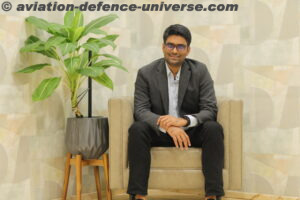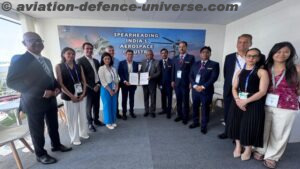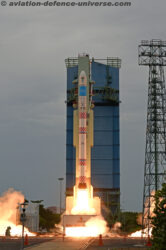New Delhi, February 25th, 2016. In what is believed to be a watershed moment for the Indian Defence Manufacturers, key industry players came together to launch DIIA – an industry association with a single minded focus on accelerating Indigenous design & development in the Indian defence sector.
DIIA champions the view point that self-sufficiency in defence can be achieved through government policies that pro-actively encourage indigenous R&D. DIIA will provide a platform for like-minded organizations to rally around, collaborate and co-operate to forge ahead in making the ‘Make by India’ a sustainable initiative. Indigenously designed, developed and manufactured products should be given higher preference is the main point that the association will promote.
Till date, this aspect of encouraging and promoting indigenous R&D has never been actively pursued by any industry association. One of the major ideological viewpoint that DIIA stands for and is attempting to promote is that it is an undeniable fact that many Indian companies, particularly MSMEs, have been spearheading intense R&D efforts to indigenize defence equipment. These initiatives and success stories need to be converted to fruitful business contracts which not only help the companies sustain themselves but aids the nation in attaining the much needed strength in being self-reliant in its defence requirements.
Speaking on this occasion, Ashok Atluri, Chairman, DIIA, said, “To say that India is one of the largest importer of defence equipment is acceptance of a great shortcoming. When you look at the value chain of high-technology complex defence equipment only 30%-40% of the costs contribute towards cost of manufacturing. Whereas almost 60% of the value is captured at the design and development level.
Strangely, till now, there has been no focus on the design and development of defence equipment in India. The focus was always on how to manufacture component or, sometimes, even equipment in India. But the IP has always been developed/owned by someone else. DIIA, as an organization, believes that focus on design and development is the only way to become a world-leader and exporter in defence equipment from being the largest importer of defence equipment. That is the only way for India to shed its dependence on imported equipment. Indian defence industry and especially the SMEs which are the cradle of innovation and creativity, can build equipment that not only meets the stringent requirements of India Armed forces but also can be exported to countries world-wide.”
Elaborating further on DIIA’s role, Atluri added, “DIIA’s will interact with Government decision makers to ensure a policy that encourages design and development of defence equipment with IP ownership in Indian companies. Furthermore, we look forward to expanding our ranks with other like-minded companies and invite them to participate actively in this movement by joining us.”.”
DIIA’s agenda include to provide credible Indian defence innovators and industry players a conducive environment and platform to discuss critical industry issues, with the defence SME’s at its core and to formulate plans to steer the conversation towards ‘Design, Develop & Make in India’ and additionally position indigenous SMEs companies as the cradles of innovation.
In addition it also plans to make a meaningful contribution to the Indian defence requirements by carefully aligning long-term defence plans and R&D strategy of the Indian Industry to enable larger domestic procurement and also exports from India and to ensure that Indian defence capabilities that have been developed are nurtured and honed to global standards while preserving them against any predatory tactics.
With the revolutionary key provision of Buy Indian (Indigenously Designed, Developed and Manufactured – IDDM) being announced in the new Defence Procurement Procedure (DPP), DIIA’s efforts seems have started to bear fruit from its inception. For the first time in the history of Indian defence procurement the importance of design and development has been recognized by Ministry of Defence. This category is going to ensure huge inflow of funds into research and development and will ensure that the scientific talent in India is engaged in developing cutting edge technologies in Defence. With such huge investments, going into R&D, India, from being a destination for outdated defence equipment, will become the source for cutting-edge technology in defence.
The inception of DIIA can be attributed to two crucial variables, firstly the positive direction provided by the current Govt policies and secondly the growing confidence of the indigenous players. The catalyst clearly has been the Make in India initiative which has reenergized the defence sector.
DIIA will strive to encourage and identify success stories to steer the Govt policy discussion towards a fruitful conclusion for the industry as a whole. With the Indian defence requirements set to cross $100 billion in the next ten years, the indigenous defence industry is well poised to address this demand and DIIA endeavors to play a pivotal role in increasing the defence self-reliance index.
DIIA members and associates today came together at the India International Centre, New Delhi to discuss and deliberate upon the various policy matters relating to the defence industry.
The inaugural conference addressed critical issues associated with the indigenous defence business community, in the form of panel discussions.
▪ National Consensus on Importance of Design & Development
▪ Accelerating Indigenous Design & Development in Defence
▪ Self-Reliance in Defence
▪ Accelerating Exports in Defence
Overall, India’s self-reliance index has remained static at about 30 per cent for the last two-and-a-half decades, with 70 per cent of the country’s defence requirements being sourced to foreign vendors making the Indian armed forces overly import-dependent. DIIA will strive to flip this ratio and, additionally, position the Indian industry as a global defence solution provider. Design, Develop & Make in India will be the key focus areas for DIIA in the foreseeable future.































































































































